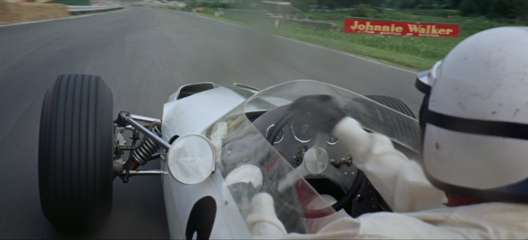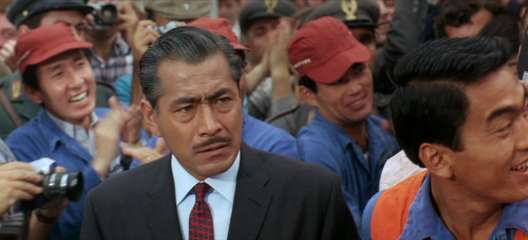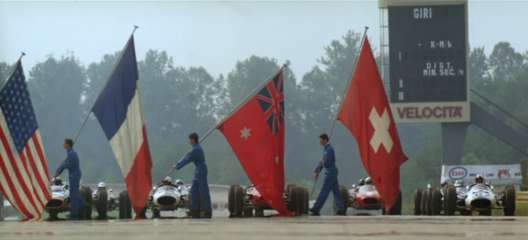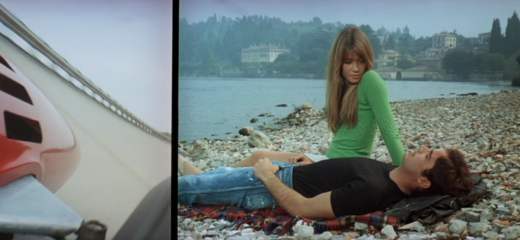Film Review: Grand Prix (1966)
Grand Prix (1966)
directed by John Frankenheimer
Frames in this review are taken from the two-disc Warner Brothers DVD,
released in July 2006.
Grand Prix is the showpiece film for Formula One racing and a cult favorite in the racing community. It shows historical racetracks from Formula One’s early days that no longer exist, and pioneered the in-car race footage that is now a staple of television footage. Yet despite its niche position in the market, the film is actually quite accessible even to someone whose only contact with racing comes from channel-surfing.
In a way, Grand Prix is the best Arthur Hailey film ever made,
even though it's not based on an Arthur Hailey novel. It brings in a
Grand Hotel-esque cast of characters, spins them around in a
blender, and spits them all out into a spectacular climax. And, unlike
that stillborn Arthur Hailey 70mm spectacle
Airport
, Grand Prix requires no artificial action
beyond what happens in the normal course of a race. The expert camera
work and careful editing give the live-action racing sequences a thrill
that is impossible to achieve with special effects.

Formula One racing
The reason to watch this film is for the racing. The surrounding plot is close to soap opera and is not that interesting. Fortunately, the racing scenes are spectacular and absorbing, shot from inside the cockpit, in the air, along the track, in a chase car, pretty much everywhere that a camera can go. The fact that most of it was shot in real life with the cars traveling at high speeds gives it a very authentic look, and some of it comes from actual Formula One races. The excitement is enhanced by the editing, with frenetic cutting juxtaposed with longer sequences that provide the viewer with situational awareness of the larger race.
There's also a fair amount of technical knowledge presented to the viewer, much of it through voiceovers from the drivers. You get a good sense about racing history and legend as they discuss the allure of the Monaco Grand Prix, a race that takes place on narrow city streets, leaving little room for passing and even less margin for error. During the climactic final race at Monza, the drivers describe how much they hate the banked high-speed curve, how the tremendous centrifugal force and bumpiness of the curve cause the cars to take a tremendous beating.
The race at Monza is almost frightening to watch, as the camera remains fairly stable on the straight sections, but shakes energetically on the banks, accompanied by the convulsive vibrations of the wheels as the suspension struggles with the road surface. Even on the straights, the drivers point out the dangers from the cars remaining in close proximity while traveling at 200 mph (320 km/h), as the slipstream effects presents trailing cars with less air resistance and encourages the cars to remain close. With such high performance demands even then, one can anticipate the edge of the envelope that is being pushed by today's computer-modeled cars, which travel so fast that they use an airfoil shape to generate negative lift for better road adhesion.

Surprisingly, the film was shot in 70mm instead of 35mm. Using film that was twice as wide and moved 25% faster surely made the racing scenes more difficult to shoot. But this Super Panavision film was originally shown on Cinerama screens, hence the long first-person point-of-view sequences. The larger film format also results in less graininess in the composites and split-screens, and this quality is visible even on DVD.
The split screen effects do feel a bit dated, and they also give too much of an avant-gard effect, especially in mosaics where the screen shows 16 repetitions of the same image. But a nice triptych effect emerges when the screen splits into thirds – especially appropriate for a film that was shown in Cinerama theaters. True Cinerama, after all, was shot on three separate pieces of film, and displays visible join lines where the three projected images come together. In thirds, the screen plays with all the possibilities: symmetric triptychs, non-symmetric triptychs, multiple-images, and Cinerama-style panoramas with the full 70mm negative used but with the split lines left in.

The soundtrack on the DVD comes from the revised edition, in which Toshiro Mifune's English is dubbed. It’s easier to understand, but the voice actor's fake Japanese accent is so overdone that it comes close to caricature. Plus, it’s slightly off-sync. In the few sentences of Japanese that Mifune’s character speaks, he sounds much more distinguished, more like the confident industrialist that he plays. The audio is generally clear, with the dynamic range really being displayed in the roars of the engines during the races.
Plot
The film opens with the Monaco Grand Prix in the streets of Monte Carlo. An accident propels driver Pete Aron (James Garner) into the harbor and seriously injures teammate Scott Stoddard (Brian Bedford). Aron finds himself persona non grata and gets kicked off the team. Nor is he welcome at his former team of Ferrari, so he does what many washed-up sports stars do — turn into a television sportscaster.
While Aron is on the sidelines, veteran Ferrari driver Jean-Pierre Sarti (Yves Montand) is racking up victory after victory and wooing American fashion magazine writer Louise Frederickson (Eva Marie Saint). His brash young teammate Nino Barlini (Antonio Sabato) is living the sixties life of sex and rock-and-roll, chasing after Lisa (French singing sensation Françoise Hardy). But all hope is not lost for our protagonist, as Japanese magnate Izo Yamura (Toshiro Mifune) enters the scene and offers him a job. He was a lousy sportscaster anyway.
Having introduced us to the main characters, the film settles into the standard plot, following the racing community on and off the course. Stoddard painfully recovers from his injury and returns to the circuit while popping painkillers, obsessed with equaling his older brother's championship record. Off the course, Stoddard's relationship with Aron becomes even icier when his estranged wife Pat (Jessica Walter) starts sleeping with Aron and modeling for Louise's magazine.
Meanwhile, Barlini moves to the top and teammate Sarti falls from grace. Sarti finds comfort in an a intellectual and empathic relationship with Louise, escaping the pressure from the Ferrari owner and from his own estranged wife. Who will win the big race, and who will lose his life in the next spectacular wreck? It is not that different from today’s dramatized sports telecasts, in which every competitor is succeeding in the face of some personal tragedy. Grand Prix makes the contrast explicit by using split-screens to simultaneously show personal and professional events.

James Garner is at ease in the role of the likable American that he cultivated in other films. But standing out from the crowd is Yves Montand, who steals every scene with a devoted yet weary performance as Sarti. Garner is a bit too likable and two-dimensional, always doing the honorable thing, whether with Pat or Yamura or Stoddard. In contrast, Sarti has a hardened side, which produces more sympathy from the viewer and from Louise. When he sees an accident on the track, he allows himself to feel no sympathy and instead puts his foot down hard, just as everyone else is subconsciously slackening off the pedal.
Toshiro Mifune brings an authoritative air to the Japanese industrialist,
much like Henry Fonda brings gravitas to even the most minor film that
he’s involved in. The Japanese tea sequence with Aron, although somewhat
formulaic, reminds us that the 1960s were the decade in which Japan
reemerged onto the world stage, hosting the
1964 Tokyo Olympics and feeling proud of the economic renaissance.
Brian Bedford presents a convincingly icy Stoddard — even in the tender
scenes with Pat, he seems right at the freezing point.
Too predictable
Unfortunately, much of the plot seems to have been added to pad out the film to three hours. Perhaps they wanted the audience at the reserved-seating roadshows to feel that they got their money’s worth. The screenplay is quite formulaic, filled with stock characters and forgettable dialog. Really, Montand must be commended for wrestling a great part out of merely an above-average role. Plus, his French accent add sparkle and sincerity to some banal dialog.
The plot elements are all too predictable. Pat leaves Scott because she is fed up with the way he'd sweat the night before a race — gosh, haven't we seen this before somewhere? And while Eva-Marie Saint always brings a plain-Jane quality to her dialog, what her character gets to say in this movie puts her dangerously close to a scattered-brained blonde reporter. You remember the men's names in the movie because they're doing something, but the women are there just to worry about them. Louise's role as a reporter is practically a throwaway, as is Pat's taking up modeling on a lark. The best part of the writing lies in the jabs that the Europeans make at the Americans. With three writers listed in the credits, including director John Frankenheimer himself, the film bears all the marks of a committee effort.
John Frankenheimer earned his reputation with taut political thrillers
like
The Manchurian Candidate and
Seven Days in May
. On this fluffier piece of Hollywood
entertainment, it seems that he put all his energies into the racing
sequences (no second unit director is credited) and phoned in the scenes
off the racing course. A similar dichotomy is visible in the technical
aspects of the film. Take the editing, which won a well-deserved Academy
Award. The race sequences are impressive indeed, but the soap opera is
cut together with less variety than a television sitcom. Standard
angles, medium-close ups, alternating cuts as the characters speak to
each other. Three people were credited for the editing, so who worked on
the race scenes and who put together the soap opera?
Similarly, Maurice Jarre's score for the racing sequences is majestic and romantic, with a certain international flavoring in its lushness. Unfortunately, it suffers the indignity of turning into Musack when it's haphazardly placed behind the soap opera scenes. There's one particularly egregious example, where Sarti and Frederickson leave a reception and go into a quiet garage, as the completely inappropriate racing march plays on at low volume behind them. There's no possible diegetic source for the music, and it is merely distracting in a scene that should’ve been left as dialog-only.
Despite its uneven nature, however, Grand Prix is sort of a guilty pleasure. The film has terrific action scenes that will thrill any fan (or not) of Formula One auto racing. Don’t be afraid to fast-forward. You won’t be missing much.